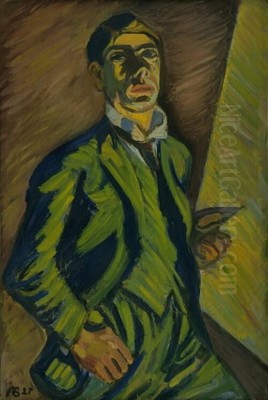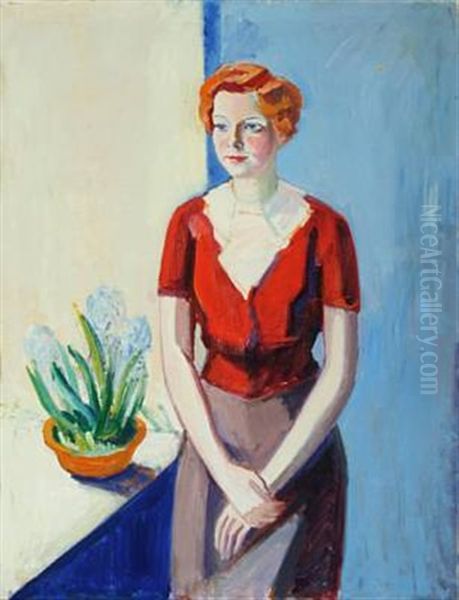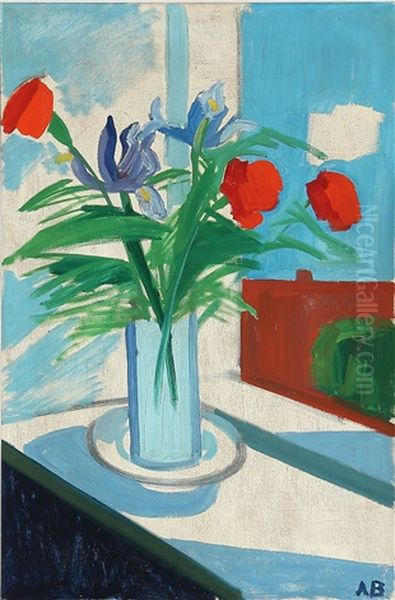
Axel Bentzen stands as a figure within the landscape of 20th-century Danish art, primarily recognized for his work as a painter. While biographical details gleaned from various records present some inconsistencies, his artistic presence is confirmed through documented participation in significant exhibitions and specific referenced works. His career unfolded during a dynamic period of artistic transformation in Denmark, coinciding with the rise and evolution of modernism. Understanding Bentzen requires piecing together fragments of information, focusing on his contributions as an artist who engaged with the aesthetic currents of his time, particularly through his involvement in Copenhagen's exhibition scene.
The available information suggests Bentzen was an active participant in the Danish art world, particularly in the early decades of the 20th century. His inclusion in notable group shows places him alongside contemporaries who were shaping the direction of modern art in Scandinavia. While perhaps not possessing the same level of widespread fame as some of his peers, his work forms part of the broader narrative of Danish painting during this era. This exploration aims to synthesize the known aspects of his artistic life, acknowledging the limitations and occasional contradictions in the source material, to present a portrait of Axel Bentzen the painter.
Biographical Threads and Uncertainties
Pinpointing the exact biographical details of Axel Bentzen presents challenges due to conflicting information found in historical records. One set of data suggests a birth year of 1877, specifically October 31st. This timeline aligns reasonably well with his documented exhibition activity starting in the late 1910s. Further complicating matters, a death date of December 21st, 1955, is associated with an Axel Harald Valdemar Bentzen, who may potentially be the same individual. This timeframe (1877-1955) provides a plausible lifespan for an artist active during the key period of Danish modernism.

However, other records introduce different possibilities, highlighting the difficulties in definitively identifying individuals across historical documents. One source mentions an Axel Bentzen born on February 8th, 1869. Another, quite distinctly, records an Axel Bentzen born in Rome on April 1st, 1921, identified as the son of an artist named Vittorio Bentzen. This 1921 birth date is inconsistent with exhibition records placing an artist named Axel Bentzen in Copenhagen shows as early as 1917. Furthermore, some sources describe an Axel Bentzen as a Danish historian with broad research interests, an identity seemingly separate from that of the painter. Given the focus on his artistic contributions and the corroboration provided by exhibition dates, the 1877-1955 lifespan appears the most likely for the painter Axel Bentzen discussed here, though the discrepancies must be noted.
The Artistic Path: Style and Approach
Axel Bentzen's journey as an artist appears rooted in painting, specifically oil painting, which was the medium for his known representative work. The limited descriptions of his artistic style suggest an approach driven by personal intuition rather than adherence to a specific programmatic movement or overt social commentary. Sources indicate his focus lay in elements fundamental to modernist concerns: composition, a distinct inclination towards certain color palettes, and the expression of emotion through visual means.
This characterization places Bentzen within the broader currents of early 20th-century art, where artists across Europe were breaking from academic traditions and exploring the expressive potential of form and color. While the provided information doesn't explicitly link him to specific influences like Fauvism or Cubism, his emphasis on composition and color suggests an engagement with the formal experiments that defined modernism. His work was seemingly less concerned with narrative or direct representation of a socio-cultural milieu and more focused on the intrinsic qualities of the painting itself – line, shape, hue, and the feelings they could evoke.
This introspective, perhaps subjective, approach aligns with aspects of Scandinavian modernism, which often balanced international trends with local sensibilities and a connection to nature or psychological states. Bentzen's art, as described, seems to prioritize the artist's internal vision and sensibility in shaping the final work. His participation in exhibitions alongside recognized modernists further supports his position within this evolving artistic landscape.
Exhibition History: A Presence in Copenhagen
Axel Bentzen's presence in the Danish art scene is most clearly documented through his participation in key Copenhagen exhibitions. These events were crucial platforms for artists to showcase their work, engage with peers, and reach audiences and critics. His involvement indicates a degree of recognition and integration within the artistic community of his time.

A significant early appearance was at the Kunstnernes Efterårsudstilling (KE), or Artists' Autumn Exhibition, in 1917. The KE, established in 1904, served as an important alternative to the more traditional Charlottenborg exhibitions. It was often a venue for younger artists and newer, sometimes more radical, artistic tendencies. Exhibiting at KE suggests Bentzen was aligning himself with the progressive wing of Danish art. During the 1917 KE, he exhibited alongside fellow painters Immanuel Ibsen (sometimes recorded as Esbensen) and Mogens Van Vort (or Vore), indicating collaboration or shared association within a particular circle of artists.
Bentzen also participated in the more established Charlottenborg Spring Exhibition in 1920. For centuries, Charlottenborg Palace had been the home of the Royal Danish Academy of Fine Arts and its official exhibitions. Acceptance into the Charlottenborg Spring Exhibition signified a level of mainstream recognition. His inclusion in the 1920 show, again alongside Mogens Van Vore, demonstrates his ability to navigate both the alternative and the established art venues in Copenhagen. These appearances in the late 1910s and early 1920s mark a key period of activity and visibility for Bentzen.
Later references place his work within the context of 20th-century Scandinavian Design and Paintings exhibitions. One such mention lists his paintings alongside those of Jeppe Vontillius and Jack Kampmann. While the specific date of this exhibition isn't clear from the snippet (the reference to 2020 might indicate a modern retrospective or sale), its inclusion suggests that Bentzen's work continued to be relevant or was rediscovered in later assessments of mid-century Danish and Scandinavian art. These exhibitions collectively map a career that spanned several decades, engaging with the primary platforms for artistic display in Denmark.
Representative Work: 'Ægypterinde' (1952)
Among the specific works attributed to Axel Bentzen, the oil painting titled Ægypterinde (often translated as 'Egyptian Woman' or simply 'Egyptian') from 1952 stands out. This piece provides a concrete anchor point in his later career, demonstrating his continued activity as a painter well into the post-World War II era. The title itself is evocative, suggesting a subject drawn from or inspired by Egypt.
The theme of Egypt and the broader "Orient" held a long fascination for European artists, dating back to the Neoclassical and Romantic periods and continuing through various modernist interpretations. Without viewing the painting, one can only speculate on Bentzen's approach. Created in 1952, it falls into a period where artists were grappling with the aftermath of war and exploring diverse stylistic paths, from abstraction to renewed forms of figuration. Bentzen's Ægypterinde might have been a figurative work, perhaps exploring exoticism through a modernist lens, focusing on form, color, and mood rather than ethnographic accuracy.
Alternatively, the title could have been a more abstract reference point. Regardless of its specific style, the existence of Ægypterinde confirms Bentzen's medium (oil on canvas, presumably) and provides evidence of his artistic production in the early 1950s, just a few years before the potential death date of 1955. It serves as a key example of his output, hinting at the subjects or themes that interested him later in his life, and solidifies his identity as a practicing painter over an extended period.
Contemporaries and the Danish Art Milieu
Axel Bentzen practiced his art during a vibrant and transformative period in Danish art history. His documented collaborations and co-exhibitions place him directly in contact with several contemporaries. His appearance at the 1917 KE alongside Immanuel Ibsen (or Esbensen) and Mogens Van Vort (or Vore) is significant. Ibsen was associated with Danish modernism, known for his explorations of color and form. The repeated exhibition connection with Mogens Van Vort, both at KE in 1917 and Charlottenborg in 1920, suggests a potentially close working relationship or shared artistic outlook during this crucial period.
The later contextualization of his work alongside Jeppe Vontillius and Jack Kampmann situates him within the broader scope of mid-20th-century Danish painting. Kampmann, for instance, was a notable figure associated with expressive, often abstract or semi-abstract, styles that gained prominence after WWII. This association suggests Bentzen's work retained relevance or found resonance with the art historical narratives encompassing these later artists.
To fully appreciate Bentzen's position, it's helpful to consider the wider circle of influential Danish artists active during his career. The early 20th century saw the breakthrough of modernism in Denmark, spearheaded by figures often referred to as the "Four Musketeers" of the movement: Harald Giersing, known for his bold lines and dynamic compositions, often depicting scenes of modern life like ballet dancers or football players; Edvard Weie, celebrated for his intense, almost Fauvist use of color and expressive landscapes and figure studies; Olaf Rude, who explored landscape painting with a modernist sensibility, simplifying forms and emphasizing color harmonies; and Vilhelm Lundstrøm, perhaps the most formally experimental, known for his Cubist-inspired still lifes and figure compositions, reducing objects to geometric forms. These artists were Bentzen's contemporaries, shaping the environment in which he worked and exhibited.
Other significant figures populated the Danish art scene. J.F. Willumsen, an older, highly individualistic artist, bridged Symbolism and Expressionism, creating powerful, often monumental works. The legacy of the Skagen Painters, such as P.S. Krøyer, Anna Ancher, and Michael Ancher, represented the late 19th-century Naturalist and Impressionist traditions against which some modernists reacted, but whose influence on Danish art remained profound. The quiet, atmospheric interiors of Vilhelm Hammershøi offered another distinct path, focusing on mood, light, and subtle tonal harmonies, representing a more introspective modern sensibility. Later in the century, figures like Asger Jorn would emerge, co-founding the CoBrA movement and pushing Danish art towards spontaneous abstraction and expressionism. Bentzen's career unfolded amidst this rich tapestry of artistic exploration and debate.
Legacy and Conclusion
Axel Bentzen emerges from the available records as a dedicated Danish painter who navigated the currents of modernism during the first half of the 20th century. His participation in significant Copenhagen exhibitions like the Kunstnernes Efterårsudstilling and the Charlottenborg Spring Exhibition confirms his active role within the professional art community of his time. These platforms allowed him to present his work alongside notable contemporaries, including Immanuel Ibsen, Mogens Van Vort, Jeppe Vontillius, and Jack Kampmann.
His artistic approach, characterized by an intuitive focus on composition, color, and emotion, aligns with the broader shift towards subjective expression and formal exploration that defined modern art. While perhaps not achieving the canonical status of some of the leading figures of Danish modernism like Giersing or Lundstrøm, Bentzen contributed to the artistic dialogue of the era. The specific mention of his 1952 oil painting, Ægypterinde, provides concrete evidence of his later work and thematic interests.
Reconstructing a complete picture of Axel Bentzen is hampered by conflicting biographical data and the relative scarcity of detailed information specifically about him compared to more famous peers. The potential confusion with other individuals bearing the same name further complicates the narrative. However, focusing on the documented evidence related to his painting career reveals an artist engaged with his time, contributing his unique sensibility to the evolving story of Danish art. He remains a figure worthy of note for those seeking a fuller understanding of the breadth and diversity of artistic practice in 20th-century Denmark. His work, situated within the context of his contemporaries and the exhibition culture of the period, forms a part of the rich artistic heritage of Scandinavia.